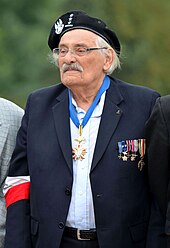Samuel Willenberg
Samuel Willenberg (born February 16, 1923 in Częstochowa ; died February 19, 2016 in Tel Aviv ) was a Polish - Israeli sculptor , author and survivor of the Treblinka extermination camp .
Life
Samuel Willenberg's father, Perec Willenberg, worked as an art teacher at a Jewish high school and was a well-known synagogue painter. His mother came from a Russian noble family. She fled to Poland after the Russian Revolution. Because his father was supposed to paint a synagogue , the family moved to Opatów shortly before the start of World War II .
After the invasion of the Wehrmacht and later the Red Army, Samuel Willenberg served as a volunteer in the Polish army at the age of 16 .
Willenberg was arrested by Germans in Opatów in October 1942. By then he had escaped arrest with forged papers. He was - as the majority of the Jewish community Opatóws - the Treblinka extermination camp deported where he claimed in the selection of the deportees to be a bricklayer. He was registered as a labor prisoner while the rest of the deportees on his transport were immediately sent to the gas chambers . In the camp, he had to sort the clothes of the recently murdered deportees. A particularly tragic experience was the discovery of the clothes of his two sisters, Tamara and Ita.
On August 2, 1943, inmates of the camp - including Willenberg - organized the Treblinka uprising to make a mass escape possible. Willenberg actually managed to escape despite a gunshot wound to the leg. He reached Warsaw , where he fought alongside the Polish underground army against the Germans in the Warsaw Uprising until the end of the war. In 1945/1946 he served as a lieutenant in the Polish People's Army .
After the war, on behalf of a Zionist organization, Willenberg looked for Jewish children who had survived the Holocaust in secret, and he succeeded in illegally bringing Jewish youth to Italy . In 1948 he married Ada Lubelczyk; she had been smuggled out of the Warsaw ghetto by her parents .
When Willenberg was allowed to leave Poland in 1950, he had to give up his Polish citizenship . He emigrated to Israel . Willenberg worked there for the Ministry of Development for forty years.
After his retirement, a “second career” began: He completed a degree in painting, sculpture and art history in Tel Aviv. His expressive sculptures show scenes and people from everyday life in Treblinka. They have already been shown in several exhibitions, including a. Also in Germany. In 1986 he published a book about the Treblinka uprising in Hebrew, which was translated into several languages. In 2009 it was published in German.
Samuel Willenberg lived in Tel Aviv with his wife Ada Lubelczyk Willenberg and their daughter. Before his death in February 2016 at the age of 93, he was the last survivor of the uprising in the Treblinka extermination camp. He was buried on February 22nd in the Moshav Udim cemetery near Netanya in the presence of the President of Israel Reuven Rivlin .
exhibition
Willenberg created 15 bronze sculptures over the course of three years. His sculptures were exhibited in various German cities from May 2008 to May 2009 under the title The Art of Memory .
Publications
- Treblinka. Camp, revolt, escape, Warsaw uprising. Unrast , Hamburg / Münster 2009 (translated by Steffen Hänschen), ISBN 978-3-8977-1820-3 (previously: Bunt w Treblince Res Publica, Warszawa 1991, ISBN 83-7046-192-1 Polish ).
literature
- Markus Götte, Michaela Christ: The art of memory. Bronze sculptures of the Treblinka survivor Samuel Willenberg . In: Medaon, 2 (2008), 3 ( online ).
Web links
- Literature by and about Samuel Willenberg in the catalog of the German National Library
- Images of several sculptures by Willenberg
- Report about Samuel Willenberg on the website of the educational institution Stanislaw Hantz
Individual evidence
- ↑ Last survivor of the Treblinka extermination camp died
- ↑ a b Willenberg: Treblinka. Page 231 (see literature)
- ↑ a b c d e Willenberg: Treblinka. Page 232.
- ^ Foreword by the Stanisław Hantz educational institute to Willenberg's book about the Treblinka extermination camp . Retrieved September 16, 2009
- ↑ a b c Willenberg: Treblinka. P. 233
- ↑ Samuel Willenberg: Last survivor of the Nazi extermination camp Treblinka died ( Memento of the original from February 20, 2016 in the Internet Archive ) Info: The archive link was inserted automatically and has not yet been checked. Please check the original and archive link according to the instructions and then remove this notice. , Deutschlandfunk , February 20, 2016; Retrieved February 20, 2016
- ↑ Last survivor of the Treblinka uprising buried. In: welt.de
- ↑ Photos for the exhibition The Art of Memory
| personal data | |
|---|---|
| SURNAME | Willenberg, Samuel |
| BRIEF DESCRIPTION | Polish-Israeli sculptor and Holocaust survivor |
| DATE OF BIRTH | February 16, 1923 |
| PLACE OF BIRTH | Czestochowa |
| DATE OF DEATH | 19th February 2016 |
| Place of death | Tel Aviv , Israel |
